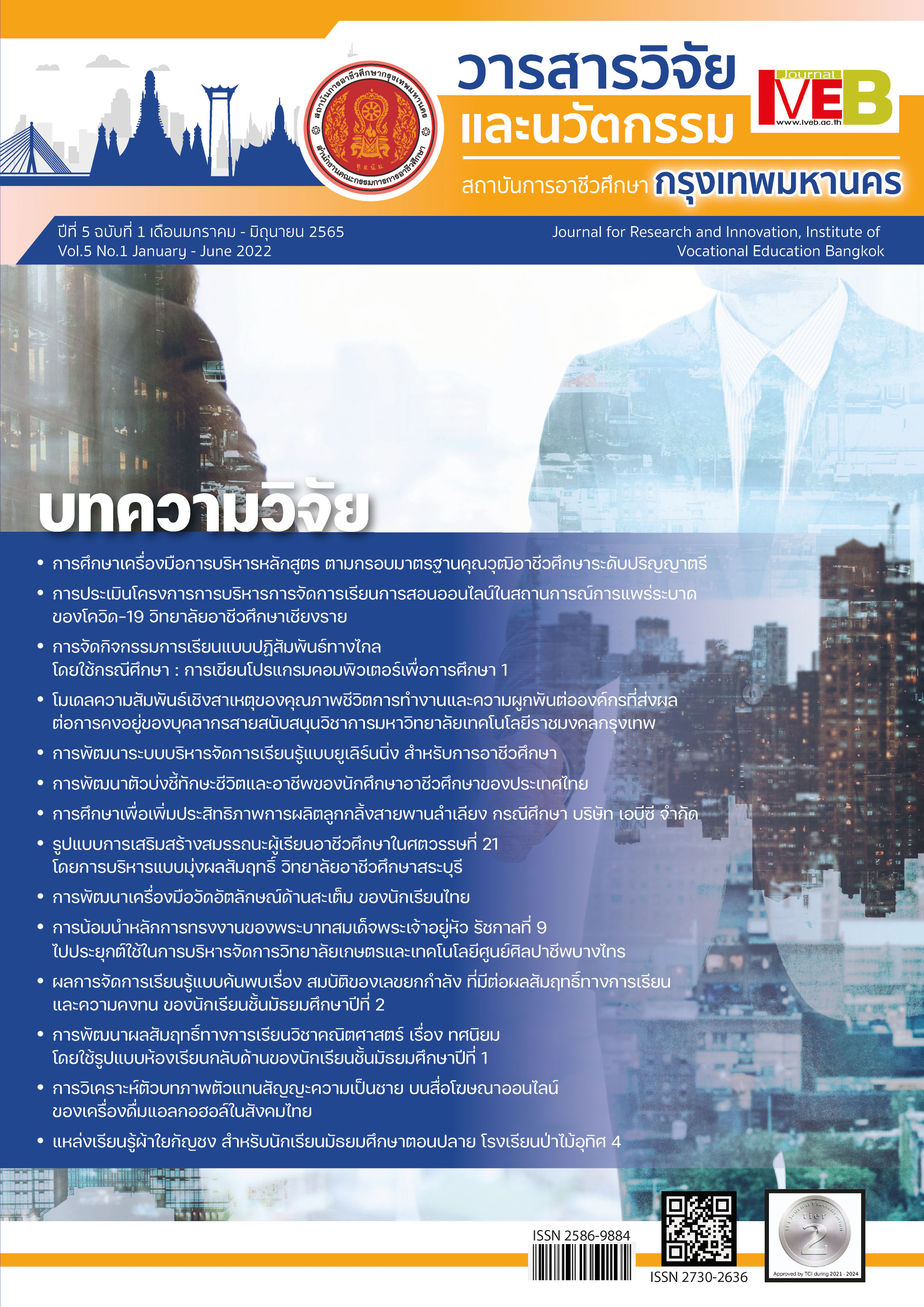การพัฒนาเครื่องมือวัดอัตลักษณ์ด้านสะเต็มของนักเรียนไทย Developing a Scale Measuring Thai Students’ STEM Identity
Main Article Content
Abstract
This article presents the process of developing a Likert scale to measure Thai students’ STEM identity. STEM identify can be defined as seeing oneself as a STEM person, which play a crucial role in students’ decision making to pursue higher education and choose STEM-related careers. Theoretically, STEM identity comprises 3 components: being interested in STEM, being recognized in STEM, and performing competency in STEM. We collected and translated 14 items from the literature and then sent these items to three experts to check construct validity. Subsequently, we gathered data from 160 secondary students to determine reliability and conduct factor analysis. The research results reveal that the scale measuring STEM identity consists of 10 items (3 items measuring interest in STEM, 4 items measuring recognition in STEM, and 3 items measuring performance in STEM). The reliability values of each component are at 0.931, 0.933, and 0.899, respectively. Factor loading of each component are at 0.862, 0.901, and 0.968, respectively. Moreover, the result of confirmatory factor analysis indicated the significant fit between the model and the data at the level of .05. (Chi-square = 30.610, df = 28, p-value = 0.3346, RMSEA = 0.024, CFI = 0.998, and TLI = 0.997). Based on the additional analysis of the data with the students’ background, that male students significantly have stronger STEM identity than female students and that students with interest in STEM-related careers significantly have stronger STEM identity than students with interest in careers not related to STEM. Future research may use this instrument to measure and examine a change in students’ STEM identity.
Article Details

This work is licensed under a Creative Commons Attribution-NonCommercial-NoDerivatives 4.0 International License.
References
[2] Vasquez, J. A. (2015). STEM: Beyond the acronym. Educational Leadership, 72(4), 10-15.
[3] Promboon, S., Finley, F. N., & Kaweekijmanee, K. (2018). The evolution and current status of STEM education in Thailand: Policy directions and recommendations. In G. W. Fry (Ed.). Education in Thailand: An old elephant in search of a new mahout (pp. 423-459). Springer.
[4] Falloon, G., Hatzigianni, M., Bower, M., Forbes, A., & Stevenson, M. (2020). Understanding K-12 STEM education: A framework for developing STEM literacy. Journal of Science Education and Technology, 29(3), 369-385.
[5] Zollman, A. (2012). Learning for STEM literacy: STEM literacy for learning. School Science and Mathematics, 112(1), 12-19.
[6] พุทธชาด อังณะกูร, ธิดา ทับพันธ์, และเสมอกาญจน์ โสภณหิรัญรักษณ์. (2563). การวิเคราะห์ความสนใจและเจตคติต่อเนื้อหาและอาชีพสะเต็มของนักเรียนระดับมัธยมศึกษาปีที่ 3 ในเขตกรุงเทพมหานครและปริมาณฑล. วารสารบัณฑิตศึกษา มหาวิทยาลัยราชภัฏวไลยอลงกรณ์ในพระบรมราชูปถัมภ์, 14(2), 105-125.
[7] Kier, M. W., Blanchard, M. R., Osborne, J. W., & Albert, J. L. (2014). The development of the STEM career interest survey (STEM-CIS). Research in Science Education, 44(3), 461-481.
[8] van Aalderen-Smeets, S. I., van der Molen, J. H. W., & Xenidou-Dervou, I. (2019). Implicit STEM ability beliefs predict decondary school students’ STEM self-efficacy beliefs and their intention to opt for a STEM field career. Journal of Research in Science Teaching, 56(4), 465-485.
[9] รัดเกล้า นุ้ยแม้น. (2561). การศึกษาปัจจัยที่ส่งผลต่อการตัดสินใจเลือกศึกษาต่อด้านสะเต็มในระดับอุดมศึกษาของอดีตผู้แทนนักเรียนไทยที่ไปแข่งขันคณิตศาสตร์และวิทยาศาสตร์โอลิมปิก สำนักงานคณะกรรมการการศึกษาขั้นพื้นฐาน ประจำปี พ.ศ. 2546-2559. วารสารจันทรเกษมสาร, 24(2), 48-63.
[10] Godwin, A., & Potwin, G. (2017). Pushing and pulling Sara: A case study of the contrasting influences of high school and university experiences on engineering agency, identity, and participation. Journal of Research in Science Teaching, 54(4), 439-462.
[11] Rahm, J., & Moore, J. C. (2016). A case study of long-term engagement and identity-in-practice: Insights into the STEM pathways of four underrepresented youths. Journal of Research in Science Teaching, 53(5), 768-801.
[12] Dou, R. & Cian, H. (2021). The relevance of childhood science talk as a proxy for college students’ STEM identity as a Hispanic serving institution. Research in Science Education, 51(4), 1093-1105.
[13] ศูนย์ดัชนีการอ้างอิงวารสารไทย. (2564). [ออนไลน์]. Thai Journals Online. [สืบค้นเมื่อวันที่ 22 ตุลาคม 2564]. จาก https://www.tci-thaijo.org.
[14] Carlone, H. B. & Johnson, A. (2007). Understanding the science experiences of successful women of color: Science identity as an analytic lens. Journal of Research in Science Teaching, 44(8), 1187-1218.
[15] Gee, J. P. (2000). Identity as an analytic lens for research in education. Review of Research in Education, 25, 99-125.
[16] Hazari, Z., Sonnert, G., Sadler, P. M., & Shanahan, M-C. (2010). Connecting high school physics experiences, outcome expectations, physics identity, and physics career choice: A gender study. Journal of Research in Science Teaching, 47(8), 978-1003.
[17] Hughes, R., M., Nzekwe, B., & Molyneaux, K. J. (2013). The single sex debate for girls in science: A comparison between two informal science program on middle school students’ STEM identity formation. Research in Science Education, 43(5), 1979-2007.
[18] Dou, R., Hazari, Z., Dabney, K., Sonnert, G., & Sadler, P. (2019). Early informal STEM experiences and STEM identity: The importance of talking science. Science Education, 103(3), 623-637.
[19] Jackson, M. C., Leal, C. C., Zambrano, J., Thoman, D. B. (2019). Talking about science interest: The importance of social recognition when students’ talk about their interests in STEM. Social Psychology of Education, 22(1), 149-167.
[20] Rodriguez, S., Cunningham, K., & Jordan, A. (2019). STEM identity development for Latinas: The role of self- and outside recognition. Journal of Hispanic Higher Education, 18(3), 254-272.
[21] Avaraamidou, L. (2020). Science identity as a landscape of becoming: rethinking recognition and emotions through an intersectionality lens. Cultural Studies of Science Education, 15(2), 323-345.
[22] McDonald, M. M., Zeigler-Hill, V., Vrabel, J. K., & Escobar, M. (2019). A single-item measure for assessing STEM identity. Frontiers in Education, 4, 78.
[23] Patton, M. Q. (2002). Qualitative research and evaluation methods. California: SAGE Publications.
[24] Wu, H. & Leung, S-O. (2017). Can Likert scale be treated as interval scales?—A simulation study. Journal of Social Service Research, 43(4), 527-532.
[25] Goss-Sampson, M. A. (2020). [Online]. Statistical analysis in JASP: A guide for students. [Retrieved on 9 November 2021] from https://jasp-stats.org/wp-content/uploads/
2020/11/Statistical-Analysis-in-JASP-A-Students-Guide-v14-Nov2020.pdf

